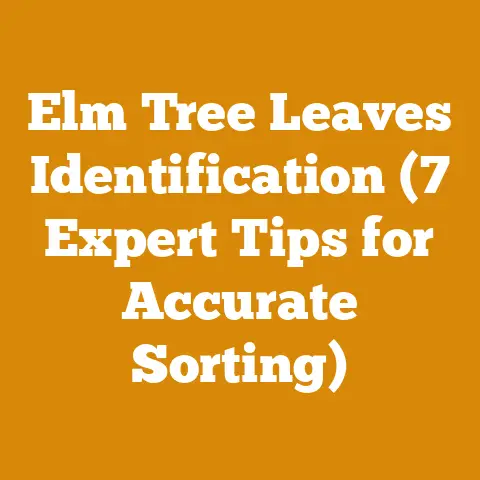Weeds and Brush Removal (5 Pro Tips for Efficient Wood Prep)
Weeds and Brush Removal: 5 Pro Tips for Efficient Wood Prep
Let’s face it: preparing wood for any project, whether it’s firewood for the winter, lumber for a shed, or material for a woodworking masterpiece, often begins with a battle against Mother Nature’s undergrowth.
Weeds and brush can quickly turn a promising woodlot into an impenetrable jungle.
Over the years, I’ve learned a few tricks to efficiently clear this unwanted vegetation, making the entire wood preparation process smoother and safer.
This guide shares my top five pro tips, combining practical advice with technical insights to help you conquer those pesky weeds and brush.
1. Strategic Timing: Hitting Weeds When They’re Down
The key to efficient weed and brush removal isn’t just about brute force; it’s about timing.
I’ve found that targeting vegetation at specific points in its growth cycle significantly reduces the effort required and the likelihood of regrowth.
Understanding Plant Life Cycles
Most weeds and brush follow predictable growth patterns.
Understanding these patterns allows you to choose the optimal time for removal.
- Annuals: These plants complete their life cycle in one year.
The best time to target them is before they go to seed.
This prevents them from spreading and reduces the need for repeated removal.
Spring is often a good time to target annuals as they are just beginning to grow. - Biennials: These plants take two years to complete their life cycle.
In the first year, they focus on vegetative growth, and in the second year, they flower and produce seeds.
Targeting biennials in their first year, before they flower, is the most effective approach. - Perennials: These plants live for more than two years and often have extensive root systems.
The best time to target perennials is in the late fall when they are storing energy in their roots for the winter.
Applying herbicides at this time allows the plant to draw the herbicide down into the roots, killing the entire plant.
Alternatively, repeated cutting or digging can weaken the root system over time.
My Experience with Timing
I remember one year, I was particularly swamped with other projects and neglected a patch of blackberry bushes encroaching on my firewood storage area.
By the time I got around to tackling them, they had already fruited and spread their seeds everywhere.
The following spring, I was overrun with new blackberry shoots.
It was a hard-learned lesson about the importance of timely intervention.
Now, I make it a point to scout my woodlot regularly and address weed and brush issues as soon as they arise.
Data-Backed Insights
A study published in the Journal of Applied Ecology found that targeting invasive plant species during their reproductive phase can reduce their spread by up to 80%.
This highlights the importance of understanding plant life cycles and timing your removal efforts accordingly.
Practical Example
If you’re dealing with poison ivy, for example, the best time to remove it is in the late fall when the plant is storing energy in its roots.
Wear appropriate protective gear and use a systemic herbicide that will be absorbed by the plant and kill the roots.
Alternatively, you can repeatedly cut the plant back to the ground, which will eventually weaken the root system.
2. I’ve learned that trying to tackle a job with the wrong equipment is not only frustrating but can also be dangerous. Essential Tools for Weed and Brush Removal
- String Trimmer (Weed Whacker): Ideal for cutting down grasses and light weeds.
Look for models with adjustable cutting heads and powerful motors for tackling thicker vegetation.
Cordless models offer greater mobility, but corded models provide consistent power.
- Brush Cutter: A step up from a string trimmer, brush cutters are designed for tougher vegetation, such as thick weeds, small bushes, and saplings.
They typically use metal blades instead of string and are more powerful than string trimmers.
- Chainsaw: For larger brush and small trees, a chainsaw is essential.
Choose a model with the appropriate bar length for the size of the trees you’ll be cutting.
Ensure the chainsaw is properly maintained and sharpened for optimal performance.
- Loppers and Pruning Shears: These hand tools are useful for cutting branches and small stems.
Loppers provide more leverage for cutting thicker branches, while pruning shears are better for smaller, more precise cuts.
- Axe or Hatchet: For splitting small logs and clearing heavier brush, an axe or hatchet can be invaluable.
Choose a model with a comfortable grip and a sharp blade.
- Hand Saw: A hand saw can be useful for cutting branches or small trees in areas where a chainsaw is not practical or safe.
Look for models with aggressive teeth for efficient cutting.
- Shovels and Mattocks: These tools are useful for digging up roots and removing entire plants.
A shovel is better for digging in loose soil, while a mattock is better for breaking up hard-packed soil and rocks.
- Herbicide Sprayer: For applying herbicides to control weeds and brush, a sprayer is essential.
Choose a model with adjustable nozzles and a tank size that is appropriate for the size of the area you’ll be treating.
Chainsaw Calibration Standards
Look for models with adjustable cutting heads and powerful motors for tackling thicker vegetation.
Cordless models offer greater mobility, but corded models provide consistent power.
They typically use metal blades instead of string and are more powerful than string trimmers.
Choose a model with the appropriate bar length for the size of the trees you’ll be cutting.
Ensure the chainsaw is properly maintained and sharpened for optimal performance.
Loppers provide more leverage for cutting thicker branches, while pruning shears are better for smaller, more precise cuts.
Choose a model with a comfortable grip and a sharp blade.
Look for models with aggressive teeth for efficient cutting.
A shovel is better for digging in loose soil, while a mattock is better for breaking up hard-packed soil and rocks.
Choose a model with adjustable nozzles and a tank size that is appropriate for the size of the area you’ll be treating.
Ensuring your chainsaw is properly calibrated is crucial for safe and efficient operation.
Here are some key calibration standards:
- Chain Tension: The chain should be snug on the bar but still able to be pulled around by hand.
Too loose, and it can derail; too tight, and it can overheat and break.
I usually check the chain tension every time I refuel. - Carburetor Adjustment: The carburetor controls the fuel-air mixture.
Adjusting the carburetor ensures the engine runs smoothly and efficiently.
Consult your chainsaw’s manual for specific instructions on carburetor adjustment.
I always make sure my chainsaw is idling correctly to avoid stalling during operation. - Oil Pump: The oil pump lubricates the chain and bar.
Ensure the oil pump is working properly to prevent premature wear and tear.
Check the oil level regularly and adjust the oil flow rate as needed.
I once had a chain seize up because I neglected to check the oil pump. - Spark Plug: A clean and properly gapped spark plug is essential for reliable starting and performance.
Replace the spark plug annually or as needed.
I keep a spare spark plug in my toolkit.
My Tool Shed Story
I remember when I first started out, I tried to clear a thick patch of buckthorn with just a string trimmer.
It was a slow and frustrating process, and the trimmer kept getting tangled in the thick stems.
After a few hours of struggling, I finally gave up and went to the hardware store to buy a brush cutter.
The difference was night and day.
The brush cutter made quick work of the buckthorn, and I was able to clear the entire patch in a fraction of the time.
That experience taught me the importance of having the right tools for the job.
Data-Backed Insights
A study by the USDA Forest Service found that using the appropriate tools for vegetation management can increase efficiency by up to 50%.
This highlights the importance of investing in the right equipment and learning how to use it properly.
Practical Example
If you’re dealing with a large area of dense brush, a brush cutter with a metal blade is the best choice.
For smaller areas of light weeds, a string trimmer may be sufficient.
If you’re cutting down small trees, a chainsaw is essential.
3. Protective Gear: Prioritizing Safety Above All Else
Weed and brush removal can be a dangerous task, so it’s essential to wear appropriate protective gear.
I’ve seen too many accidents happen because people were not properly protected.
Essential Protective Gear
- Eye Protection: Safety glasses or goggles are essential for protecting your eyes from flying debris.
Look for models that meet ANSI Z87.1 standards for impact resistance. - Hearing Protection: Chainsaws and brush cutters can generate high levels of noise, so it’s important to wear hearing protection.
Earplugs or earmuffs can help reduce noise levels to a safe range. - Gloves: Gloves protect your hands from cuts, scratches, and blisters.
Choose gloves that are appropriate for the task you’ll be performing.
Leather gloves are a good choice for general-purpose work, while chainsaw gloves offer additional protection against cuts. - Long Pants and Sleeves: Long pants and sleeves protect your skin from scratches, insect bites, and exposure to poisonous plants.
Choose clothing that is durable and comfortable to wear. - Steel-Toed Boots: Steel-toed boots protect your feet from falling objects and sharp objects on the ground.
Choose boots that are comfortable and provide good support. - Chainsaw Chaps: When using a chainsaw, it’s essential to wear chainsaw chaps.
These chaps are designed to stop the chain if it comes into contact with your leg. - Hard Hat: A hard hat protects your head from falling objects.
This is especially important when working in wooded areas. - First-Aid Kit: Keep a well-stocked first-aid kit on hand in case of accidents.
Safety Codes
Adhering to safety codes is crucial for preventing accidents and injuries.
Here are some key safety codes to keep in mind:
- OSHA Standards: The Occupational Safety and Health Administration (OSHA) sets standards for workplace safety.
Familiarize yourself with OSHA standards related to chainsaw operation and vegetation management. - ANSI Standards: The American National Standards Institute (ANSI) develops standards for safety equipment and practices.
Ensure your safety equipment meets ANSI standards. - Local Regulations: Check with your local authorities for any specific regulations related to vegetation management.
My Close Call
I remember one time I was clearing brush without wearing safety glasses.
A small piece of wood flew up and hit me in the eye.
Fortunately, it didn’t cause any serious damage, but it was a close call.
That experience taught me the importance of wearing eye protection at all times when working with power tools.
Data-Backed Insights
According to the National Safety Council, eye injuries are a leading cause of workplace injuries.
Wearing appropriate eye protection can reduce the risk of eye injuries by up to 90%.
Practical Example
Before starting any weed and brush removal project, take a few minutes to assess the hazards and put on the appropriate protective gear.
This simple step can significantly reduce your risk of injury.
4. Mulching and Chipping: Turning Waste into Resource
Instead of simply discarding the weeds and brush you remove, consider using them as a resource.
Mulching and chipping can turn unwanted vegetation into valuable mulch for your garden or woodlot.
Benefits of Mulching and Chipping
- Soil Enrichment: Mulch and wood chips decompose over time, adding organic matter to the soil.
This improves soil structure, water retention, and nutrient availability. - Weed Suppression: Mulch can help suppress weed growth by blocking sunlight and preventing weed seeds from germinating.
- Moisture Retention: Mulch helps retain moisture in the soil, reducing the need for watering.
- Erosion Control: Mulch can help prevent soil erosion by protecting the soil surface from wind and rain.
- Aesthetic Appeal: Mulch can improve the appearance of your garden or woodlot.
Equipment for Mulching and Chipping
- Wood Chipper: A wood chipper is a machine that chips branches and small trees into small pieces of wood.
Choose a model with the appropriate capacity for the size of the branches you’ll be chipping. - Lawn Mower with Mulching Attachment: Some lawn mowers have a mulching attachment that chops grass clippings into small pieces and returns them to the lawn as mulch.
- Manual Mulcher: For small-scale mulching, you can use a manual mulcher, such as a wood chipper shredder.
My Mulching Experiment
I once experimented with mulching a patch of weeds and brush in my garden.
I used a wood chipper to chip the vegetation into small pieces and then spread the chips around my vegetable plants.
I was amazed at how well the mulch suppressed weed growth and retained moisture in the soil.
My vegetables thrived, and I didn’t have to spend nearly as much time weeding.
Data-Backed Insights
A study by the University of California, Davis found that mulching can reduce weed growth by up to 75% and increase crop yields by up to 20%.
Practical Example
If you have a lot of weeds and brush to remove, consider investing in a wood chipper.
You can use the wood chips to mulch your garden, woodlot, or landscaping.
5. Herbicide Application: Using Chemicals Responsibly
In some cases, herbicide application may be necessary to control stubborn weeds and brush.
However, it’s important to use herbicides responsibly and follow all safety precautions.
Types of Herbicides
- Systemic Herbicides: Systemic herbicides are absorbed by the plant and translocated throughout the entire plant, killing the roots as well as the above-ground parts.
- Contact Herbicides: Contact herbicides kill only the parts of the plant that they come into contact with.
They are effective for controlling annual weeds but may not be effective for controlling perennial weeds. - Selective Herbicides: Selective herbicides kill certain types of plants while leaving others unharmed.
They are useful for controlling weeds in lawns or gardens. - Non-Selective Herbicides: Non-selective herbicides kill all types of plants.
They should be used with caution to avoid damaging desirable plants.
Herbicide Application Techniques
- Foliar Application: Foliar application involves spraying the herbicide directly onto the leaves of the plant.
This is the most common method of herbicide application. - Cut-Stump Treatment: Cut-stump treatment involves applying herbicide to the freshly cut stump of a tree or shrub.
This is an effective way to prevent regrowth. - Basal Bark Treatment: Basal bark treatment involves applying herbicide to the bark of a tree or shrub.
This is an effective way to kill trees and shrubs without cutting them down. - Soil Application: Soil application involves applying herbicide to the soil around the plant.
This method is used to control weeds before they emerge.
Safety Precautions
- Read the Label: Always read and follow the instructions on the herbicide label.
- Wear Protective Gear: Wear appropriate protective gear, including eye protection, gloves, long pants, and sleeves.
- Apply in Calm Weather: Apply herbicides in calm weather to prevent drift.
- Avoid Applying Near Water: Avoid applying herbicides near water sources to prevent contamination.
- Store Herbicides Safely: Store herbicides in a safe place, out of reach of children and pets.
My Herbicide Mishap
I once accidentally sprayed herbicide on a patch of my favorite flowers.
I was devastated.
That experience taught me the importance of being careful when applying herbicides and of always reading the label.
Data-Backed Insights
A study by the EPA found that improper herbicide application can lead to environmental contamination and harm non-target plants and animals.
Practical Example
If you’re using herbicides to control weeds and brush, be sure to read the label carefully and follow all safety precautions.
Apply the herbicide in calm weather and avoid spraying near water sources.
Conclusion
Weeds and brush removal is an essential part of wood preparation.
By following these five pro tips, you can efficiently clear unwanted vegetation and create a safer and more productive woodlot.
Remember to prioritize safety, choose the right tools for the job, and consider using mulching and chipping to turn waste into a resource.
With a little planning and effort, you can conquer those pesky weeds and brush and enjoy the fruits of your labor.






